Secrets of proper reproduction, cultivation and care of decorative leafy begonia
Begonias are the most common indoor flower in Europe and probably in the world. This is due to the fact that there are so many different species and varieties in the begonia family.
Content:
- General information about begonia
- Types of begonias
- Caring for decorative leaf begonia
- Plant propagation
- Transplant of decorative foliage begonia
- Diseases and pests
General information about begonia
Many flowers, including some varieties of begonias, are popular because they have unusual shapes or colors. Decorative foliage begonia does not have spectacular or unusual colors, all its varieties are different colorful leaves, which have an unusual shape and color.
Decorative deciduous begonias are mainly bushes, the sizes of which can be from 15 cm to 1 meter in height.
The homeland of this plant is tropical rainforests and highlands. Back in the 19th century, breeders began to develop new varieties and hybrids of this colorful plant.
Despite the fact that the world there are about 1000 species, only 125 are used for decorative purposes, and many of their hybrids and varieties.
Types of begonias
Royal begonia:
- This kind grows in a small bush... Its leaves are large, in length they can reach 30 cm, but the stalk on which they are located is much shorter.
- The width of the leaf is 20 cm, towards the top it tapers, forming a sharp tip, heart-shaped, wavy edges.
- The outer part of the leaf is green with a silvery bloom, slightly pubescent, on the underside it is painted in a reddish tone, pubescence goes along the veins.
Metallic begonia:
- This begonia bush releases its branches to a height of 1.5 meters.
- The stems are reddish, strongly pubescent.
- The leaves are ovoid, their length can be up to 17 cm, width up to 10 cm.They are painted in a greenish-olive tone, the veins of a reddish hue stand out brightly.
- The entire sheet is covered with a metallic sheen, as it were. The reverse side of the leaf has a purple tint.
Begonia Mason:
- The height of this type of begonia does not exceed 50 cm.
- Stems are recumbent, small in size, fleshy and thickened, strongly pubescent.
- Leaves are shaped like a heart, taper towards the end, forming a sharp nose. Their color is unique, the brown pattern stands out brightly on the greenish tone of the leaf.
Begonia Griffith:
- The leaves of this begonia are located on long petioles, the height of which can reach 30 cm.At the same time, the Griffith begonia bush does not exceed 50 cm.
- Leaves are asymmetrical, ovoid. In its core, at the very stem, the blades are found one on top of the other, creating a unique shape and elegant look.
- The leaves are painted in a dark olive color with a wide silvery stripe along the edges from the outside and with a light green stripe on a reddish background from the lower side.
- Petioles and leaves are densely pubescent with purple hairs.
Begonia Diadem:
- One of the most beautiful begonias. Large leaves are on elongated petioles.
- The shape of the leaf resembles a diadem in appearance, it is rounded with pointed ends, which, as it were, cut the leaf. The leaf is decorated with white spots that lie in a beautiful pattern on a dark green tone.
- The lower part of the leaf is colored purple.
Begonia Tiger:
- This type of begonia forms a small bush with a large number of leaves on thin elongated petioles. The shape is asymmetrical, heart-shaped, pointed at the end.
- The leaf color is bright green with a lot of brown spots.
- Petioles and leaves are slightly pubescent.
Begonia Cleopatra:
- Medium-sized bushy plant. Begonia Cleopatra has kidney-shaped leaves with jagged edges.
- They are painted green, and along the veins there is a burgundy pattern, due to which the leaves look strictly and effectively.
Imperial begonia:
- A herbaceous bush that grows up to 40 cm in height.
- The leaves are reniform, the edge is pointed, asymmetrical.
- The color is dark green with a beautiful creamy metallic pattern.
- Petioles are low, large, slightly pubescent.
White-colored begonia:
- The branches of this begonia stretch up to 60 cm in height.
- Leaves are large, heart-shaped, asymmetrical, pointed at the end. They are located on short petioles. Not pubescent, glossy.
- Dark green color with many small white spots.
This is all several beautiful varieties decorative foliage begonias. It is impossible to list and describe everything, it is best to see how beautifully this plant grows by experience.
Caring for decorative leaf begonia
Begonia is native to the rainforest, therefore, caring for her appropriately... She does not like very high or low temperatures. In summer, the air around should be warmed up by no more than 25 degrees; in winter, a decrease to 18 is allowed.
Decorative foliage begonia loves lighted places, so it is necessary to put it in that part of the house where the sun is most of the day.
But it is worth avoiding direct sunlight on the flower, especially in the summer, as burns will appear on the leaves in the form of dry spots. In summer, the begonia should be shaded; in a particularly hot period, it is recommended to remove it from the windowsill and put it in a bright room.
Watering the plant:
- Soft water is best for watering the plant.
- Begonia does not tolerate overflow of water and stagnation of moisture in the soil, this can lead to decay of the roots and death of the plant. But you should not allow the earthen coma to dry out either.
- Watering should be abundant only in the hot summer months, in autumn and winter it should be reduced.
- The time to water the plant is easy to determine by testing the moisture content of the soil.
- In a pot, it should dry out by 1-2 cm, after which you can water the plant with water.
It is also worth paying attention to the fact that begonia needs moist air.
But you should not spray it with a spray bottle, since brown spots appear on the leaves when water gets on the leaves. If you don't have a humidifier, you can put containers of water near the pots with these plants, which will gradually evaporate, humidifying the air around the plant.
Periodically decorative leafy begonia requires feeding... Nitrogen fertilizers are perfect for this. After it, the leaves become larger, fleshy, acquire a lively shine and a healthy look.
Plant propagation
The easiest and most effective way to propagate begonias is by cuttings. Almost all types of decorative deciduous begonias are successfully propagated using deciduous cuttings.
Cutting begonia:
- To do this, cut with a sharp knife adult healthy leaf together with the leg, almost under the base. Of course, it is worth carrying out this procedure carefully so as not to hurt the rest of the leaves.
- The cut stalk must be placed in water for 7-15 days. During this period, new roots form on the stem, and if such a stalk stays for a month, then new leaves may appear.
- Further, the rooted leaf must be planted in a small pot for strengthening.
- The soil must be soft, loose. Be sure to fill the drainage at the bottom of the pot.
- Next, the cuttings are carefully planted in the prepared soil.
- After 2-4 months, when the plant has strengthened the roots and released several new leaves, it can be transplanted into a larger pot.
It is best to choose the middle month of spring as the period for grafting, and it is advisable to transplant young rooted shoots in mid-autumn.
Also commonly used propagation with seeds... This process is more laborious than the previous one and requires more attention and time.
The best period for sowing seeds is late winter and early spring. IN
the specially prepared substrate is carefully laid out the seeds. Since they are very small, you should not sprinkle them with earth. Further, they must be covered with glass or film - build a small greenhouse and regularly water from a spray bottle. The container with seeds should stand in a bright, well-lit place, and the air temperature around should be maintained at around 25 degrees.
When the seedlings hatch, they must be regularly ventilated, opening the film or glass for a while.
With the further development of the sprout, the greenhouse must be removed. When 3 leaves appear on small begonias, they are transplanted into a box at a distance from each other. And after another 2 months, each plant separately in small pots. When the plant finally gets stronger, it can be transferred to a permanent place of growth.
Many bush begonias can be propagated with by dividing the bush:
- This process is carried out in the spring when the plant is transplanted. Shrub begonias are overgrown and overgrown.
- There is correspondingly little space in the pot, so such a plant can be planted. To do this, the entire bush is carefully removed from the pot, the young bushes are separated and immediately transferred to a new container for further growth.
- So from one old bush, you can disconnect 5-7 new ones. Since such sprouts generally always have a well-formed root and leaves, additional rooting is not required.
- Young begonias are planted in a permanent place of growth.
Transplant of decorative foliage begonia
Basically, all plants are transplanted in mid-spring, begonia is no exception. Young plants are replanted every year as the size of the pot increases, while mature plants are replanted only as needed.
The day before transplanting, the plant must be well watered.
It is also worth preparing the ground and drainage. Begonia must be carefully removed from the pot, check all the roots, free them from old dried out processes. It is recommended to treat it with a solution of potassium permanganate.
Further, to the bottom of the container drainage is falling out and some earth. A flower is installed and covered with pre-prepared soil. But do not fill the pot up to the top, as later roots may appear, which will need to be hidden under fresh soil.
After the plant is transplanted, it must be watered again abundantly and moistened regularly. When the earth dries up and the earth settles a little, you can add and water the flower again.
Diseases and pests
If the begonia begins to appear dry on the leaves, or many leaves wither, therefore, there is very dry air around it. The lack of light can also be determined from the leaves. With strong shading of the flower, the color of the leaves becomes pale and painful, such a flower must be exposed to the sunny side.
In the autumn-winter period, it is necessary to ensure that the air and soil are not heavily waterlogged... This can lead to the appearance of powdery mildew, in which plaque appears on the leaves, they dry out and die.
It is also worth protecting the plant from spider mites and aphids.
Decorative foliage begonias are mainly used in decorating winter gardens and home window sills. These plants look spectacular alone and look great when combined with other plants or with other varieties of the same species. Landscaping any room with begonia will give it a unique look.
Also, scientists have found that substances that secrete begonia leaves are able to fight harmful bacteria around it. Therefore, it is not only possible to place such a flower, but also useful in any room of the apartment.
More information can be found in the video.



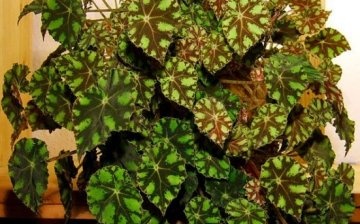
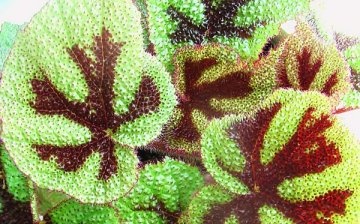
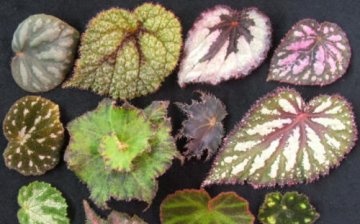
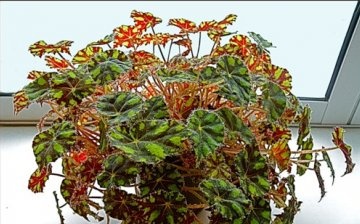
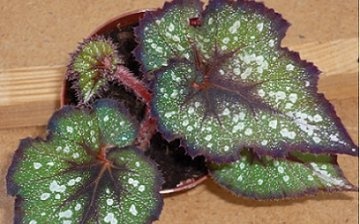
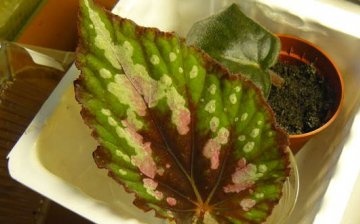
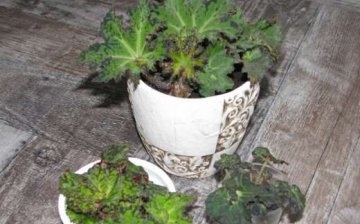
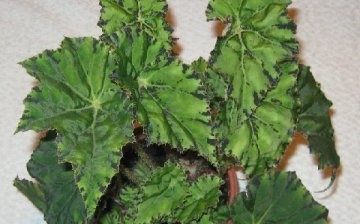








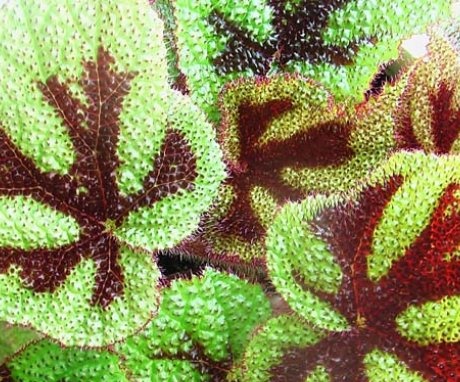
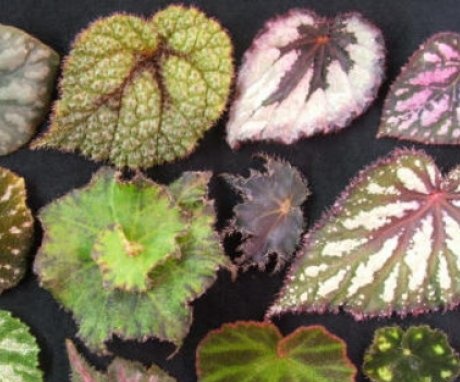
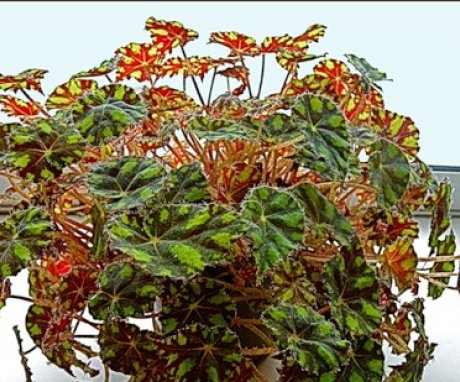
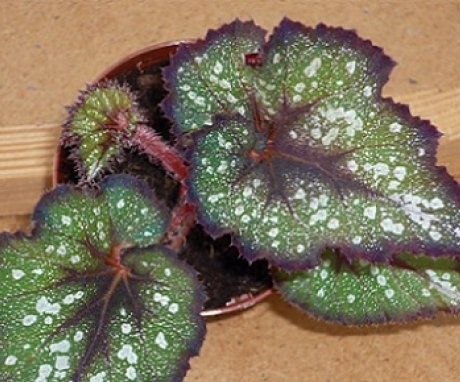
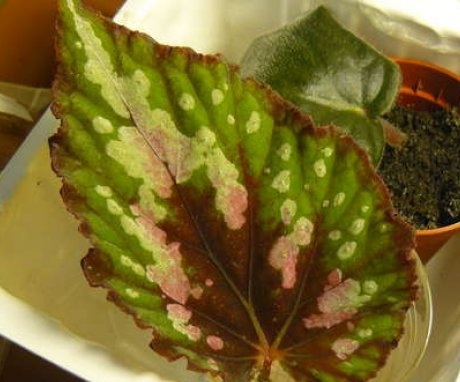
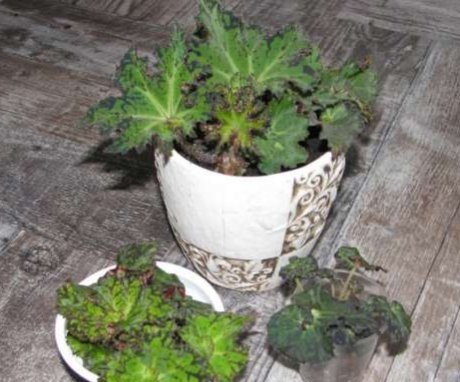
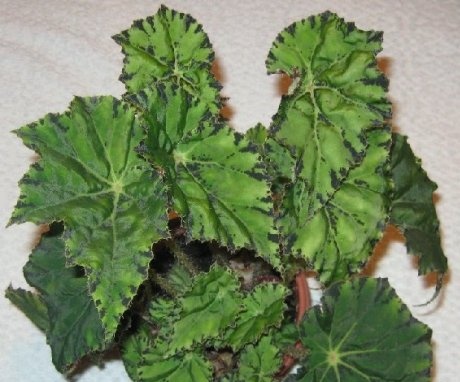
Recently, my begonia has a dramatic decrease in the size of new leaves, perhaps I need additional feeding?